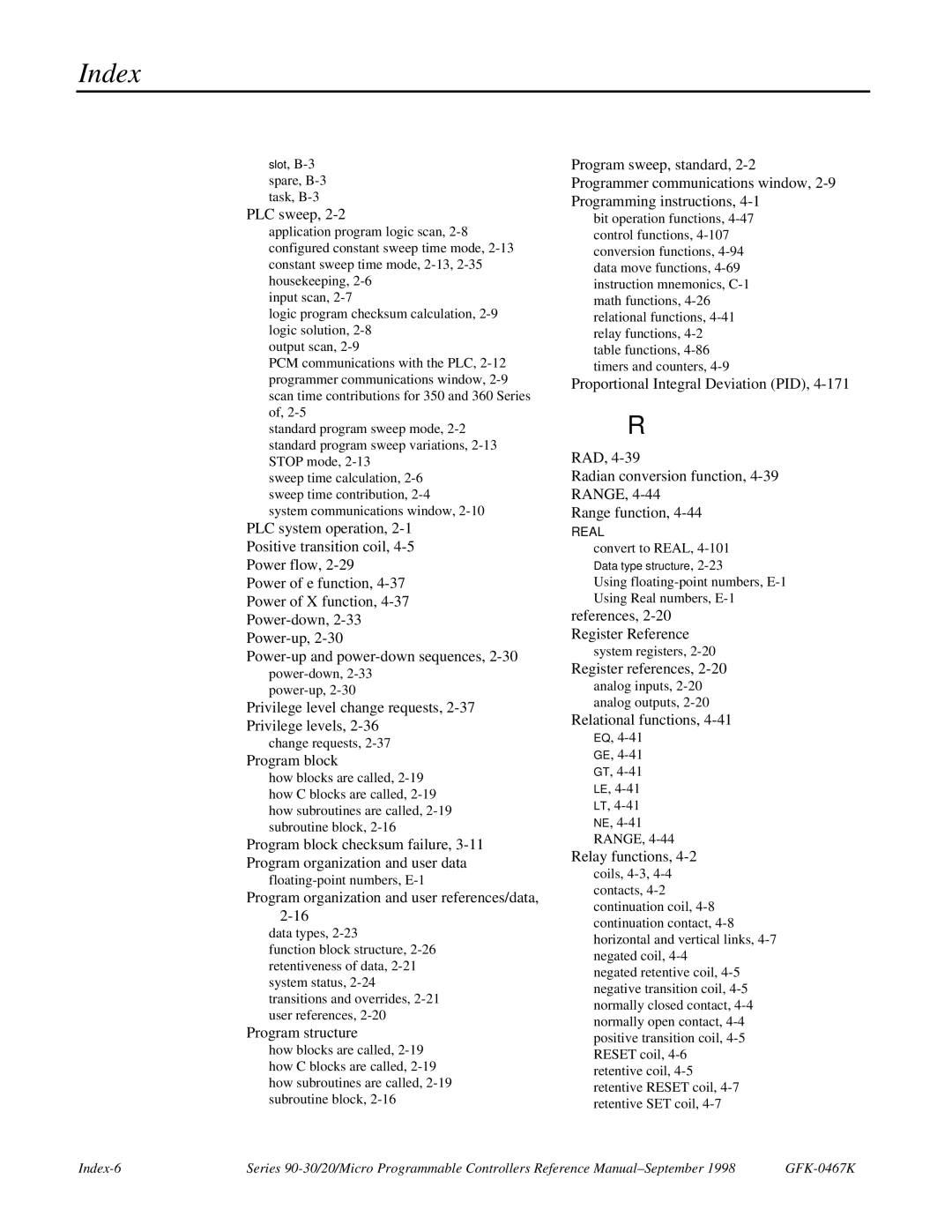slot, B-3spare, B-3task, B-3
PLC sweep, 2-2
application program logic scan, 2-8configured constant sweep time mode, 2-13constant sweep time mode, 2-13,2-35housekeeping, 2-6
input scan, 2-7
logic program checksum calculation, 2-9logic solution, 2-8
output scan, 2-9
PCM communications with the PLC, 2-12programmer communications window, 2-9scan time contributions for 350 and 360 Series of, 2-5
standard program sweep mode, 2-2standard program sweep variations, 2-13STOP mode, 2-13
sweep time calculation, 2-6sweep time contribution, 2-4system communications window, 2-10
PLC system operation, 2-1Positive transition coil, 4-5Power flow, 2-29
Power of e function, 4-37Power of X function, 4-37Power-down, 2-33Power-up, 2-30
Power-up and power-down sequences, 2-30
power-down, 2-33power-up, 2-30
Privilege level change requests, 2-37Privilege levels, 2-36
change requests, 2-37
Program block
how blocks are called, 2-19how C blocks are called, 2-19how subroutines are called, 2-19subroutine block, 2-16
Program block checksum failure, 3-11Program organization and user data
floating-point numbers, E-1
Program organization and user references/data, 2-16
data types, 2-23
function block structure, 2-26retentiveness of data, 2-21system status, 2-24transitions and overrides, 2-21user references, 2-20
Program structure
how blocks are called, 2-19how C blocks are called, 2-19how subroutines are called, 2-19subroutine block, 2-16
Program sweep, standard, 2-2Programmer communications window, 2-9Programming instructions, 4-1
bit operation functions, 4-47control functions, 4-107conversion functions, 4-94data move functions, 4-69instruction mnemonics, C-1math functions, 4-26relational functions, 4-41relay functions, 4-2
table functions, 4-86timers and counters, 4-9
Proportional Integral Deviation (PID), 4-171
R
RAD, 4-39
Radian conversion function, 4-39
RANGE, 4-44
Range function, 4-44
REAL
convert to REAL, 4-101Data type structure, 2-23
Using floating-point numbers, E-1Using Real numbers, E-1
references, 2-20Register Reference
system registers, 2-20
Register references, 2-20
analog inputs, 2-20analog outputs, 2-20
Relational functions, 4-41
EQ, 4-41
GE, 4-41
GT, 4-41
LE, 4-41
LT, 4-41
NE, 4-41
RANGE, 4-44
Relay functions, 4-2
coils, 4-3,4-4contacts, 4-2continuation coil, 4-8continuation contact, 4-8horizontal and vertical links, 4-7negated coil, 4-4
negated retentive coil, 4-5negative transition coil, 4-5normally closed contact, 4-4normally open contact, 4-4positive transition coil, 4-5RESET coil, 4-6retentive coil, 4-5retentive RESET coil, 4-7retentive SET coil, 4-7
